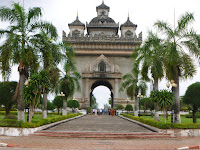We found the hotel we stayed in sixteen years ago. It’s located on the other side of the main Rue (street in English, Lao being a former French colony, there are no streets, only Rues) running parallel to the Mekong River. Jim remembered where it was by the big radio antenna next to it. We went in the hotel and talked with an Australian professor who, when he comes to Vientiane stays in the hotel, and has been staying there for twenty years. The hotel is the Day Inn Lao Hotel, and is French owned. The restaurant where we found the Laotian woman whose family lived in Liberal, Kansas, is gone, and in its place is a big hotel. The Rues leading up to the hotel are now paved, sixteen years ago they were dirt.
On the way we stopped by a temple so Laura could photograph and met a monk who had lived in San Francisco, California. He was going to be a monk for a week so his parents could go to heaven. Apparently if you do not serve as a monk sometime during your life, your parents will not enter heaven. His father had recently died so he was making sure his father would go to heaven.
We also went to Patuxai, which is also known as "The Vertical Runway”. This monument was built by the Lao government using money and cement which the U.S. provided to build a runway, hence the name. When we were here before the area around the monument was dirt. Now, it is the most popular park in Vientiane.
This is a sign on the wall describing the building: "From a closer distance, it appears even less impressive, like a monster of concrete"..
The final stop was That Dam Stupa.
Here's the Wikipedia article on it: "The That Dam is a large stupa in Vientiane, Laos. Many Laotians believe it is inhabited by a seven headed nāga who tried to protect them from the armies of Siam, who invaded in 1827. It is also known as the Black Stupa, the English translation of the Lao name "That Dam"."
Jim likes the English pronunciation of the name, which seems to be his feeling toward seeing all these temples and stupas.





No comments:
Post a Comment